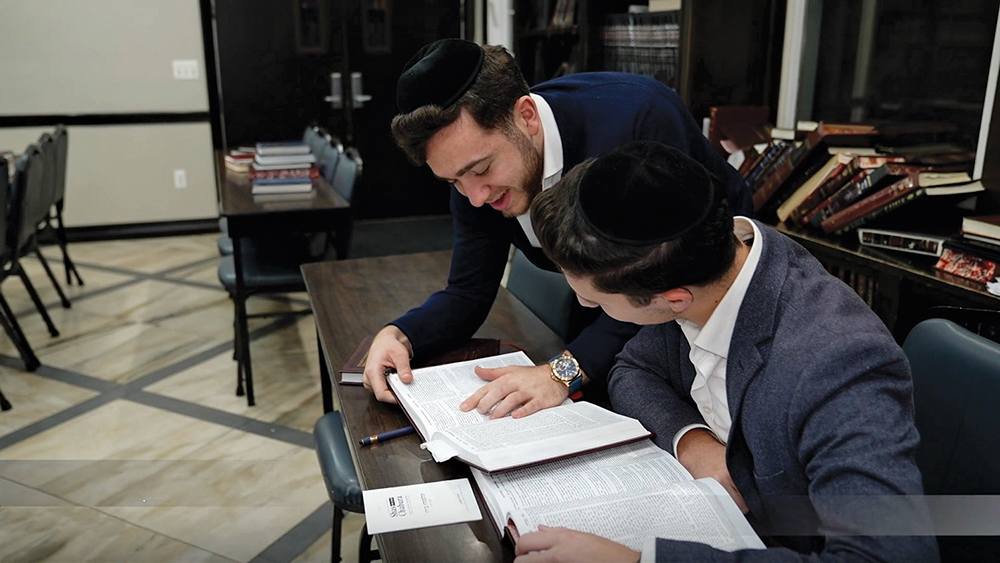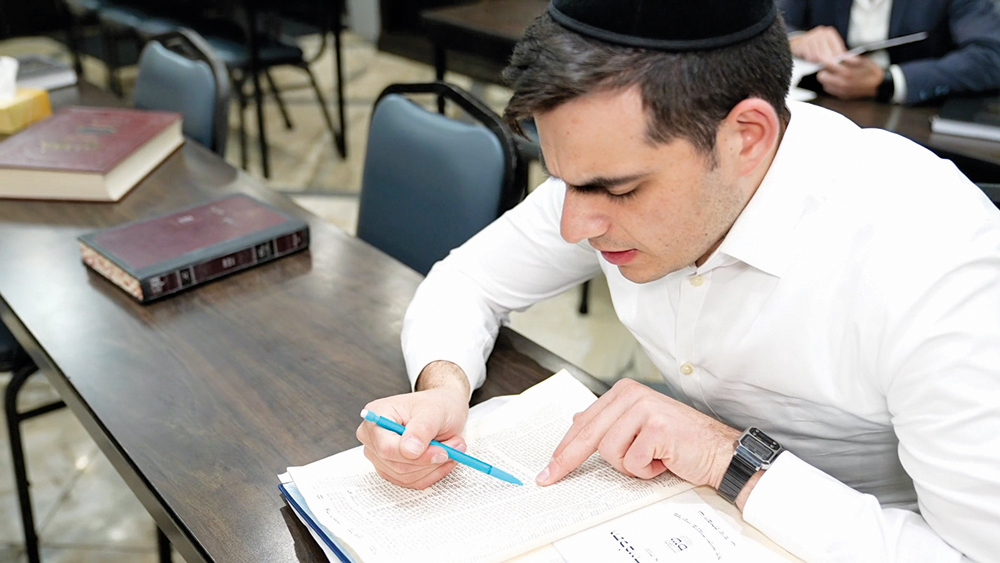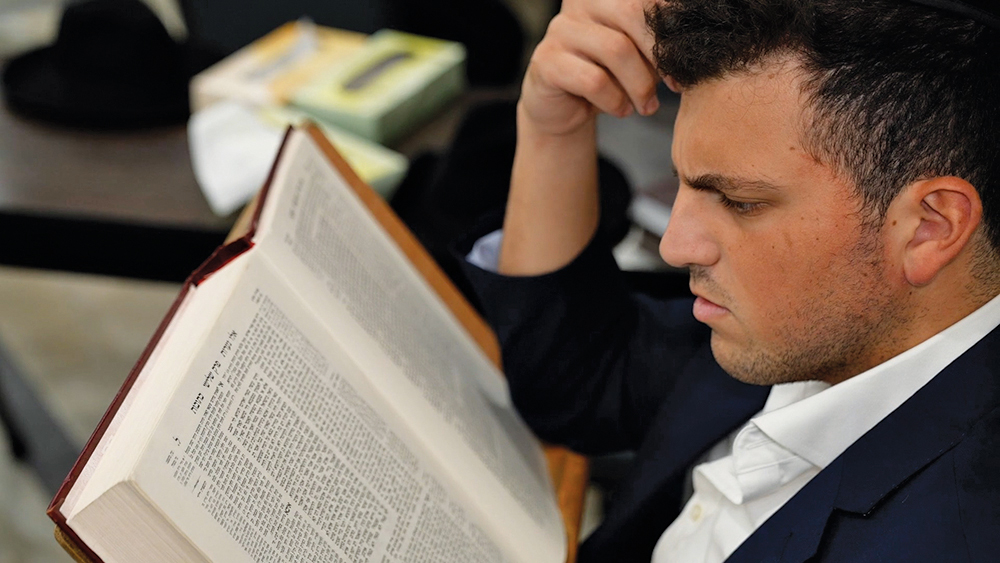
(Courtesy of Shas Chabura) Do you feel a lack of satisfaction and simcha in your learning due to a lack of comprehension of the sugya?
Do you feel that you quickly forget what you are learning?
Do you feel that even if you review your learning, it doesn’t last, and when you come back to look at the daf, you feel like you are beginning it for the first time?
If you answered yes to any one of them, then the Shas Chabura webinar is for you.
The importance of talmud Torah, Torah study and being kovea ittim b’Torah—a set time to learn Torah, particularly the Daf Yomi, is something that anyone who learns the daf is committed to accomplish. A very significant part of that talmud Torah is focusing on the simcha and achieving the satisfaction that one’s learning can bring him if they learn, review and remember what they learned. Hopefully you will be inspired, b’ezras Hashem, by the content in the Shas Chabura webinar that is described here, and can be seen on torahanytime.com or by going to shaschaburah.org.
The Shas Chabura webinar and its program will help take you to go from ordinary to extraordinary.
Rabbi Sender Dolgin puts it this way: “Many of us attend a daily shiur or a chavrusa with great self-sacrifice and mesiras nefesh. At the same time, many of us feel a lack of comprehension and retention, which robs us of the ability to feel the simcha that our learning should be giving us. Shas Chabura was created to give a person direction and purpose, so that he can experience simcha with each day’s learning. This can be accomplished with two simple directions:

- Every day, one learns new material and reviews what he did yesterday, a week ago, a month ago, three months ago and once a year. By going forward and reviewing the past, one will feel a simcha with each chazara (review) as a new piece of Gemara, or a Rashi or a Tosfos becomes clarified. Eventually, all the pieces come together, and the idea of forgetting a Gemara will become a thing of the past.
- A person should have a rebbe, or a Schottenstein or an Artscroll to teach him the relevant Gemara and the relevant Rashi or Tosfos needed for peshat. However, it must be emphasized that we are not trying to know the Gemara the first time or the second time, but rather, we are trying to become familiar with the Gemara—and with future chazara’s—the clarity will come together.”
Rabbi Eytan Kobre, a proponent of the Daf Yomi, said: “I would like to share some thoughts about my own personal experience with Shas Chabura, Rabbi Dolgin’s program. It’s a program based on cycles at various intervals of review—based on how human memory works and how we retain what we have learned. And I began to see that as I went through those cycles, I would revisit a Gemara that I hadn’t seen in many months, and, all of a sudden, it was coming back to me. There was a familiarity, because I had been through this Gemara two or three times and, even though I hadn’t made a specific attempt to retain the information—simply through the process of review at those intervals—it was coming back to me. In addition to the fact that I am able to actually remember what I have learned, I find that it’s a way to be suffused with Torah. It’s almost like Torah is enveloping you. I have never had that experience before in other programs that I have tried. What I find in Shas Chabura is that it builds to a point where each day, I am learning five blatt in different places in a mesechta, or sometimes in two mesechtas at once. It could be a daf a day; it could be an amud a day; perhaps, it could be even less than an amud a day, the beauty of the program is that it’s just a keili, it’s a vessel, and you put into it what you are able to, given who you are and what your life looks like.
But what it does is that it gives you the ability to be able to feel good about your learning because you remember what you have learned, you retain it. All I can say to people—either those who have gone through Shas with Daf Yomi or trying it for the first time—is to give a serious look at Shas Chabura as a way that you can really feel good about your learning, feel good about yourself and make the most productive use of your time and be able to really grow in Torah.”
Rabbi Pinchas Kugielsky is a successful businessman, who utilizes the program to go through Shas on a regular basis. Here’s what Rabbi Kugielsky has to say: “So, I was always chazering Torah; my whole life, I was chazering. But I never ever maintained it past a few months. But now, baruch Hashem, with this program, you remember Gemaras that you learned years and years ago, because you’re continuously always chazering every Gemara you learn. It’s very, very worthwhile, and it’s a tremendous investment in your learning.”
Rabbi Yitzchok Sorotzkin, shlita, lauds the program and the value of chazara in general—in particular here with the Shas Chabura program. Here’s what Rabbi Sorotzkin has to say: “I remember, when I was a bachur in yeshiva, there was a big dagesh on chazara. This was the way it was done in those days, there was a dagesh in covering ground and a dagesh of chazara. And, slowly, that petered out… I am familiar with Rabbi Sender Dolgin’s program, and it’s an excellent program. And maybe, it’s hard at the beginning, maybe you’ll think it’s too difficult and it’s really everything—you have to shteig into it. And that’s the way everybody who vaxed ois did—they worked slowly and they got to a level where the more you learn, the more you get siyata dishmaya, the easier it is for you. The Ribbono Shel Olam will give everybody siyata dishmaya to be matzliach and to grow and to be able to retain and to chazer. You don’t even realize how much you really can do because you tend to believe that you don’t have those kochos, but the Ribbono Shel Olam will help you to be able to accomplish it—if you really want it badly and undertake to do it.”
Rabbi Chanina Brudny is the rosh yeshiva of Yeshiva Gedolah Tiferes Yaakov Yitzchok. Here’s what Rabbi Brudny has to say: “These bachurim—from the yeshiva of Toras Yaakov Yitzchak—who joined Shas Chabura, have had their lives changed completely. Shas Chabura changed them as people. And that is because Shas Chabura gives them an achrayus (responsibility) in learning. It gives them clarity in learning. It gives them simchas hachaim, simchas haTorah. And that completely changed them. This is on off-Shabbosim and in bein hazmanim, as well. Every single day, they have chiyuvim to learn, they have blatt to learn. These bachurim have already finished close to 700, 800 blatt in the last year—chazara and chazara and chazara, just getting something klar (clear).”

Mendy Freilich and a group of his chaveirim at Yeshiva Gedoloh Tiferes Yaakov Yitzchak are achieving extraordinary new levels of limud haTorah via the Shas Chabura review program—in ways that more and more bachurim are learning—and gives them simchas hachaim and excel in their learning in ways that they never even imagined. Here’s what Mendy has to say: “Coming out of first year beis midrash, I really wanted to finish a masechta. I thought about it for a long time, and I decided what is really going to really push me is if I decide to finish Bava Kamma 10 times. The problem is that two or three months in, I started realizing that I was forgetting what I learned in the beginning of the zeman. Then, I was losing the good feeling of satisfaction of being koneh a masechta because I was already forgetting what I had originally learned. I was a little bit down. Hashem sent me one of my rabbeim, Rabbi Yoffee, shlita, and he put his arm over my shoulder and he says, ‘Mendy, what is going on?’ “Rebbe, I wanted to finish a masechta 10 times, but I’m up to like lamed bais, I’m already forgetting what I learned at the beginning.”
And he said, ‘Mendy, I actually know a program called, “Shas Chabura.’” And he explained to me how it works, the feeling of satisfaction that you will have of being koneh Gemaras by constantly chazering it in a geshmake way. It’s really incredible. It gave me such chizuk. And that’s what allowed me to finish Bava Kamma 10 times. Any time you open up a Gemara and someone asks you a question from that Gemara, you have seen it seven, eight, nine, 10 times; it’s a real satisfying feeling.
When I made my siyum in Bava Kamma—when I finished it 10 times—I felt like a different person. I felt like a new being. I’m twenty years old now, and my goal is to continue for another 11 years, and finish Shas when I’m 31. And I think it’ll be seven times.”
Here’s what Shuey Grossman has to say: “I will never ever forget the night Mendy made a siyum. I still remember, I walked in from the lunch room, I came in and Mendy walked out of the beis midrash. To say his face was shining would be an understatement. The push he gave me, the drive he gave me, to see Mendy—someone who is just like you’d say like any other guy, but on a whole different level—glowing, shining. How his father got up, and he was so proud, ‘Look what my son accomplished.’ How the rosh yeshivas got up and spoke, “Look at what Mendy did.” The thought went through my mind that, maybe, I could also do that. And I made a kabbala at that siyum, at that moment. That siyum has changed my life because it gave me this program. And it will do the same for you.”
“People look for enjoyment. And people are always searching to be happy. People spend hundreds, thousands of dollars, tens of thousands of dollars, to try to get a perfect vacation, just to try to relax and try to enjoy life just a little bit more. People can buy life for $34.99—an Artscroll Gemara. It didn’t just change my life; it gave me a new one.”
Here’s what Yosef Schorr has to say: “One of the greatest things for me is when you see a different Gemara that just quotes the Gemara you learned a month ago, it’s the coolest thing! Now that I do Shas Chabura, I come home for bein hazmanim, I come home on an off-Shabbos, every day I’m going out to learn for an hour-and-a-half to the beis midrash, and my parents are looking, “Wow, look how great he is! Look how awesome he is; he’s going out to learn.” And even in the beis midrash, you run in with multiple Gemaras, and everyone is thinking, ‘What is this guy doing?’ If anyone asks me if they should take on Shas Chabura, I would tell them—100%. If you have the time or even if you don’t have the time, you have got to do it!”
Shas Chabura is a zach (thing) that literally changes people’s lives.
Rabbi Sender Dolgin reflects: “I am zoche to be able to see every blatt in Shas once a year. I feel like I haven’t seen my best friend in a year. I give him a shalom aleichem (welcome); I can remember last year the Gemara was like Greek and Chinese, now the lights are on. And I say the word, “unbelievable” many times a day … I come here to the beis midrash not because I have to, but because there is nothing in the world that I would rather do than sit with my Abaya and my Rava. This is life-transformational. My tefilla is that everybody should feel this simchas haTorah. And with this all the brachos that the Torah guarantees will come. And with this, we’ll bring Mashiach tzidkeinu.”
For more information on Shas Chabura and to get a free Talmudo Byado booklet, call 732-447-4201 or visit the website www.shaschabura.org. The Shas Chabura webinar and podcast with a brief introduction to it can be seen by going to shaschaburah.org. To hear the webinar by phone call 718-298-2077, press 9, then 275994#. To hear the podcast by phone call 718-298-7077, press 9, then 278243. If you are an app user, you can sign up for the app by going to the app store Google Play.
Start today and hatzlacha rabba!












